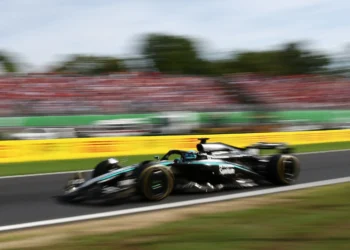After months of speculation and setbacks, General Motors, through its Cadillac brand, has officially secured its place as Formula 1’s 11th team, marking a historic milestone for American motorsport. The team will debut in the 2026 season and plans to produce its own power unit starting in 2028, signifying a long-term commitment to competing at the pinnacle of global racing.
This announcement concludes a dramatic saga that began earlier this year when the FIA initiated the bidding process for an additional team on the F1 grid. While the Michael Andretti-led Andretti Global was initially given the green light by the FIA, the entry faced opposition from Formula One Management (FOM). The breakthrough came after significant changes within Andretti Global, with Michael Andretti stepping back from day-to-day operations and his partner, Dan Towriss, taking the reins. Soon after, Cadillac’s entry was approved, bringing the iconic American manufacturer into the F1 fold.
Mario Andretti: The Legacy Continues
F1 legend Mario Andretti, a key figure in the new venture, reflected on the journey that brought Cadillac to Formula 1. Despite his son Michael stepping back, Mario has remained an integral part of the project and now serves as a director on the Cadillac F1 board. Speaking about the bittersweet nature of Michael’s reduced involvement, Mario offered a pragmatic perspective:
“There’s a celebration here with him as well. There’s no big issues that I see among the group here. Ultimately, it wasn’t just [about] Michael; there were a lot of things going on. We’re not losing a beat anywhere by going forward here.”
Why Cadillac Succeeded Where Andretti Global Stumbled
One of the lingering questions has been why Andretti Global, under Michael’s leadership, faced resistance, while the Cadillac project was approved. Mario Andretti addressed this, pointing to complex factors beyond a single issue:
“There seemed to be some personal things there that personally, I still do not understand. But it seemed like it came down to that. If that was the case, Michael decided to step aside—he might have been thinking of that anyway.”
Despite the initial hurdles, Cadillac’s entry represents a unified vision. The team will integrate state-of-the-art engineering, cutting-edge facilities, and a deep-rooted passion for racing, positioning itself as a serious contender on the F1 grid.
Looking Ahead: The Cadillac Vision for F1
Cadillac’s entry aligns with Formula 1’s growing global appeal, especially in the United States, where interest has surged thanks to events like the Miami, Austin, and Las Vegas Grands Prix. With plans to develop its own power unit by 2028, Cadillac aims to establish itself as a force in the sport.
The team’s journey starts in 2026, but the real innovation lies ahead with its power unit project, showcasing Cadillac’s commitment to technological advancement and competitive excellence. As Mario Andretti emphasized:
“The fact that it’s there now, that’s all I’d like to think about and talk about quite honestly.”
Conclusion: A New Dawn for American F1 Aspirations
The confirmation of Cadillac’s F1 entry is a triumph for American motorsport, blending legacy and ambition. It marks the first time in decades that a major American manufacturer has committed to F1 at such a scale, with plans for homegrown engineering and a vision for sustainable success.
For fans and competitors alike, Cadillac’s arrival is not just a new team on the grid—it’s a statement of intent, signaling that the United States is ready to play a pivotal role in shaping the future of Formula 1.










